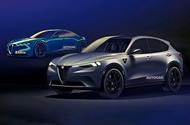The new Giulia and Stelvio will be built in Cassino, Italy
Sporting saloon and SUV will be based on new Stellantis STLA Large platform, upgraded with 800V electricals
The next-generation Alfa Romeo Stelvio SUV will make the switch to electric power when it arrives in 2025. It will be followed by a new Giulia saloon in 2026, and Alfa Romeo will go EV-only a year after.
The duo will be the first STLA Large-based cars to use 800V electricals, hinting that they will fully exploit the new Stellantis platform’s potential in hot Quadrifoglio guise.
The quickest STLA Large cars will crack the 0-62mph sprint in around 2.0sec – almost half the 3.8sec and 3.9sec times claimed by the current V6-engined Stelvio QV and Giulia QV.
The new Dodge Charger Daytona – the first performance car to use the platform but with 400V electricals – offers outputs of up to 670bhp and so can hit 60mph in 3.3sec.
It also packs a 93.9kWh (usable) battery pack, which delivers a range of 317 miles in the 496bhp R/T model, according to the US’s EPA test cycle (which is tougher than the WLTP regimen used in Europe).
This can be recharged at rates of up to 183kW, allowing a 20-80% refill in 27 minutes.
However, the use of 800V electricals in the Alfa duo will doubtless allow for a substantially faster charging rate. It’s possible that it will rival the recently upgraded Porsche Taycan, which can now take up to 320kW.

The higher voltage could also allow Alfa to reduce the current at which the electrical system runs, allowing for thinner wiring and thus a significant reduction to the car’s weight.
This could prove key to ensuring the new cars are to match the dynamic capabilities of their predecessors, given the 400V Charger tips the scales at a hefty 2648kg.
To that end, the Giulia and Stelvio will also be fitted with active anti-roll bars and a terrain-detection system.
The cars will also be the first to use Stellantis’s new STLA Brain computer architecture, which promises to bring a marked upgrade to the cars’ onboard technological offerings.
Alfa said this would enable greater flexibility of dynamic character, with customisation possible on the fly using artificial intelligence. The cars will also be updated over the air throughout their lifetimes, with periodical software updates for further refinement.
Inside, each car will remain firmly focused on the driver, with Alfa CEO Jean-Phillipe Imparato having committed to a conservative approach to the cars’ digital offerings.
Speaking to Autocar in July 2023, he said: “I respect what Mercedes is doing with its digital technology, of course, but my customers aren’t looking for metre-wide infotainment screens in their cars or 200 digital assistance systems to switch on and off.”
Imparato added that the cars will both retain the signature ‘cannocchiale’ (telescope) instrument binnacle while gaining a larger infotainment display.

The head-up display may also provide assistance to the driver, such as projecting a ‘ghost’ car ahead to help them to pick the right line through a tricky bend.
“This feels like something an Alfa should do,” said Imparato, adding: “It’s helping you to drive the car and keeping you engaged in the process. What I don’t need is to know is the weather for three weeks’ time. I don’t care – I’m here to drive.”
Both the Stelvio and Giulia will be built at the Cassino plant alongside one or more Maserati models, also based on STLA Large.
Source: Autocar
